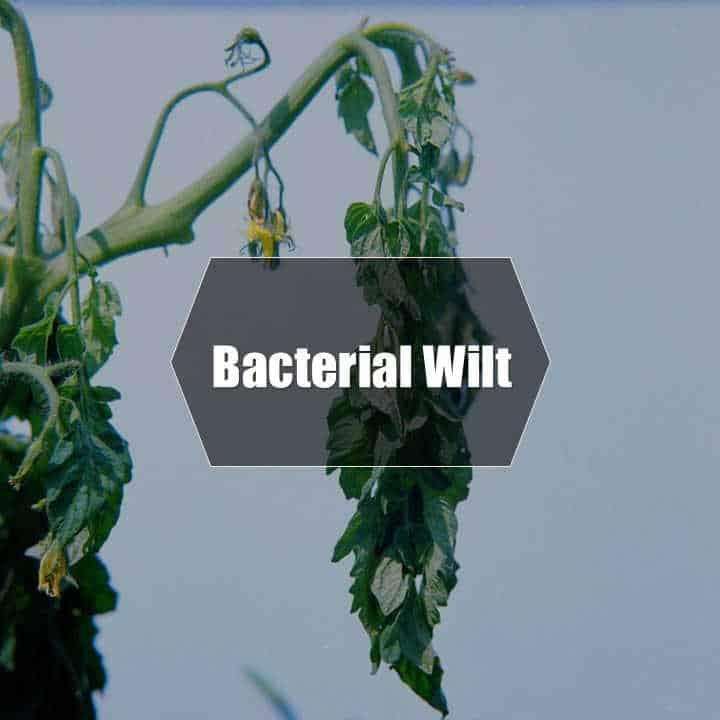Mainly two types of wilt infected the plant. Bacterial wilt and another Fusarium wilt. Fusarium wilt is less destructive and can control easily. Any fungicides e.g Copper fungicide can control fusarium wilt.
But the bacterial will cannot control easily. It attacks suddenly and can reach fast many vegetable crops, trees or shrubs. So it is destructive enough that you must know how to diagnose and treat it.
This article will help you to find the cause and treatment of bacterial wilting of banana, tomato, potato, brinjal, chillis, etc.
Before the specialized treatment for specific crops, let’s talk about the Ins and out of the bacterial wilt.
In a Hurry here is the fungicide that may help you to get rid of bacterial wilt-
Bacterial Wilt Causes, Symptoms, Diagnosis, and Treatment
Bacterial Wilt
The wilting disease is manifested by wilting the leaves and stems of affected plants. It causes the sudden stop of sap circulation in the vessels of diseased plants because of several possible species of pathogenic bacteria. This phenomenon can lead to the rapid death of plants.
Causes of Bacterial Wilt
Bacterial wilt is mainly caused by Enterobacteriaceae, Erwinia tracheophyta, and Burkholderiaceae, Ralstonia solanacearum. When one of these bacteria infects a plant, it spreads by its vessels from the point of contamination to the main stem, then in all the plants.
Life Cycle of Bacterial Wilt
These bacteria cannot live in a dry atmosphere. However, they can survive in winter in weeds or in the digestive tract of certain insect pests such as beetles, locusts, or various insects. They can also survive in greenhouse plants.
In spring, during the rapid growth phase of various plants that are susceptible, these bacteria mechanically come into contact with them penetrate by wounds of their epidermis. Cultural care or insects are responsible for these wounds. The presence of an aqueous film around the wounds facilitates this penetration.
Plants Susceptible To Bacterial Wilt
Many cultivated vegetables or ornamental plant species can undergo their attacks. Many Cucurbitaceae can infect with Erwinia tracheiphila. Melon and cucumber are particularly sensitive, squash and watermelon a little less. Solanaceae crops (tomatoes, potatoes, eggplant, peppers) and olive, banana, tobacco are potential victims of Ralstonia solanacearum.
Symptoms and Damage of Bacterial Wilt
The first symptoms appear on isolated leaves or stems, then the whole plant wilts and dies. When the stems of these plants are cut, they can exude a creamy white sap.
Because of the attack Erwinia Tracheophyta, the wilting can limit to a few stolons of melon and immediately invade the plant, and eventually plant dies. On large leaves first appears peripheral chlorosis, then they become necrotic.
On tomatoes, Ralstonia solanacearum also causes wilting of leaves and stems, but also the appearance of a bunch of adventitious roots near the soil. This same bacterium causes flowering of the seed potatoes, but also a dark brown vascular ring from which can escape the infected sap of cream color. As for potatoes, when the infection is very advanced, they exude the same whitish liquid from their eyes and their attachment heel.
Notes: Below I have discussed in details about bacterial wilt of Tomato, Banana, Rice, and Potato)
Bacterial Wilt Contamination Factors
The main source of contamination is due to cultural practices (use of infected material) and the introduction of infected plants or tubers (potatoes).
Good to know: seeds do not transmit these infections.
Lastly, a particularly humid climate or untimely irregular watering of the foliage favors the contaminations. The presence of weeds or infected re-seeding is a favorable factor. On the other hand, the presence of dried infected plant residues is not a risk because these bacteria do not survive from one year to another in a dry atmosphere.
Diagnose Bacterial Wilt
You have to diagnosis Bacterial wilt observing the physical signs of wilting and the rapidity of their diffusion in the affected plant.
In case of appearance of a beginning of bacterial wilt, avoid confusing it with wilting of other origins. For example, those due to water stress (usually occurring at temperatures above 35 ° C) are rapidly reversible after water supply. The same applies to the Fusarium fungus attack, which can also cause wilting, but at the same time has rotten collars and bulbs.
Bacterial Ooze test for Diagnosis Bacterial Wilt
Method 01
- Cut a diseased stem near the ground level.
- Place the cut stem vertically in a clear water glass.
- Milky substances running out if plant infected.
Method 02
- Cut a diseased stem in the middle
- Bring the two severed ends back into contact.
- Separating them again slowly, thin whitish filaments form between the two faces in contact due to the viscosity of the bacterial liquid.
Prevent Bacterial Wilt
On a field where crops have already suffered this disease, you can prevent its reappearance by some simple measures to apply:
- Use resistance varieties.
- Mix pseudomonas with compost and treat your soil of the land.
- Mix 10g Streptomycin into 10 Liters water and soak your seedling into the solution about 10 to 20 minutes before transplantation.
- Remove all the weeds around your crop.
- Rotate your crops with plants that are not prone to it. It is advisable to wait for 2 to 3 years before replanting in the same place other plants that are sensitive to it.
- Remove Cucumber beetle and Colorado beetle from your garden (Apply pyrethrin or carbaryl (Sevin) to get rid of these beetle)
Chemical Control for Bacterial Wilt
The fight against bacterial wilt is essentially preventive. Prophylactic measures can prevent or curb the appearance of this plant pathology and the spread of the bacteria. The selection of uninfected plots and the use of pathogen-free seedlings, resistant varieties, and crop rotation are preventative measures. To limit the spread of the pathogen, contaminated plants and plant residues must be destroyed. Agricultural implements, equipment must be disinfected. If the plants have already affected you can be applied streptomycin: water solution (10g:10L) in 7 days interval with the proper drainage system.
Symptoms and Treatment of Bacterial wilt of specific Crops
Bacterial Wilt of Tomato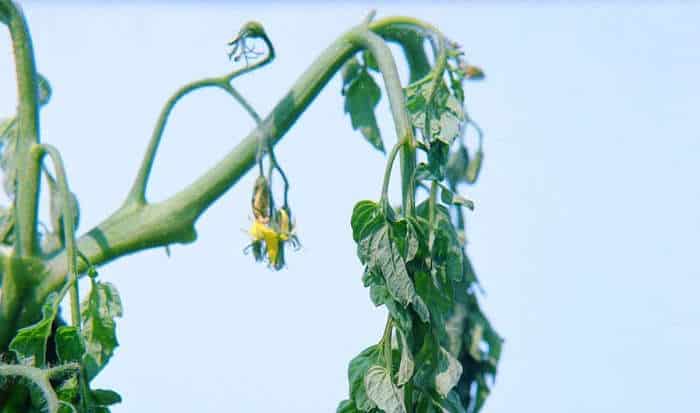
Symptoms and Damages
Ralstonia solanacearum is the pathogen of bacterial wilt of tomato. This bacterium lives in the soil and is able to live prolonged for several years at a depth of 30 cm. Irrigation practices, bruising of cultivated plants, runoff water, and agricultural tools facilitate the spread of this bacteria.
The bacterium R. solanacearum causes the wilting of the Solanaceae family’s plant. The first symptoms(unilateral discoloration) can appear on younger leaves. Gradually, the whole plant withered and died.
Bacterial wilt of Solanaceae can be confused with bacterial canker (Clavibacter michiganensis subsp. michiganensis). The vascular tissues at the base of the stem are darker than bacterial canker and browning often occurs in the marrow and cortex then progresses down the stem towards the roots.
The bacteria attack the roots and then clogs the stem. It thus prevents the circulation of water and nutrients. The leaves are deprived of nutrients and appear the symptoms of this bacteriosis, including foliage wilting.
Other symptoms may appear in the neck with the emergence of adventitious roots on the main stems. The interior of the infected stems is soaked with water and marked by brown staining of the vascular system. At an advanced stage, the stem can be hollow. A cut of contaminated stems, ooze a sticky exudate dominated by a milky white color into the glass of water.
The bacterium keeps in the soil for several years and penetrates Solanaceae through their roots. Many weeds are likely to be carriers of the bacteria: purslane, amaranth, some euphorbia.
The presence of root injuries boosts penetration. Also, note that the presence of nematodes can increase the severity of damage related to Ralstonia.
The bacterium spreads easily in the soil through runoff. Thus, the most impressive attacks are often observed in the rainy season.
How to Control Bacterial Wilt of Tomato
The fight against bacterial wilt is essentially preventive. Prophylactic measures can prevent the appearance of bacterial wilt of tomato and the spread of the bacteria. Control measure you should follow:
- Use pathogen-free seedbeds and transplants, uncontaminated irrigation water.
- Contaminated plants and plant residues must be destroyed, tools and equipment must be disinfected.
- Before planting tomato plants, flood the land for 1 to 3 weeks.
- Plant resistant rootstocks or BW-resistant tomatoes.
- Crop rotations with non-susceptible plants: cabbage, lettuce, sweetcorn corn, rye, beans, etc.
- Combine tomatoes with green onions.
- Destroy contaminated plants.
- Ensure good soil drainage.
- Work last on infected plants.
- Do not compost the infested plants.
- Spray Streptocycline@0.3g/L or other tomato fungicide and bactericide 2 times at 10-day intervals after transplanting.
Notes: Tomato and Eggplant are the Solanaceae family’s plant. Bacterial wilt of eggplant symptoms and control measures are almost the same.
Bacterial Wilt of Banana
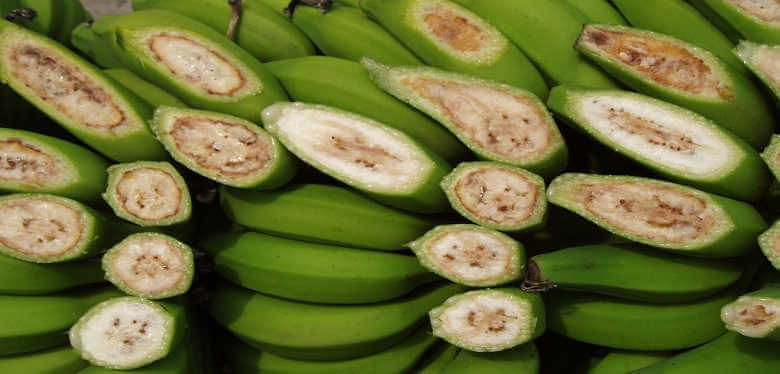
Bacterial wilt of banana, or banana Xanthomonas wilt (often called BXW), is a relatively new disease that infects bananas.
Symptoms and Damages
The leaves turn yellow and fall, and young plants flower prematurely. The plants die about a month after the infection. The disease spreads easily through insects or through infected tools or clothing.
All banana varieties are susceptible to Bacterial wilt of banana, but no chemical treatment is effective, as only good agricultural practices can use to control it.
Uganda is the most affected country. The country aimed at training farmers on the cultural practices to adopt to prevent the disease from spreading. The success of the project in Uganda brings a little hope.
This project involved 3,000 farmers and put forward very simple methodologies, without chemicals, using locally available materials such as planting only clean plants, applying wood ash to fight the disease. Remove the male flowers by hand instead of cutting them with a knife which promotes the spread of plant-bacteria to the plant.
How to Control Bacterial Wilt of Banana
- Use clean and sterilized planting materials.
- Control the access of animals, workers/laborers.
- Remove male flowers manually after the formation of the last fruit hand.
- After emergence bagging the inflorescence shortly with a polyethylene bag or muslin cloth to reduce the insect vectors.
- Clean the farm tools regularly.
- Dazomet (Basamid®granular 97%) solution is the good soil sterilizer for this disease.
- The quantitative application of organic matter (e.g., compost, rice husk powder, and bagasse) and inorganic fertilizer (NPK) can eradicate the infestation.
Bacterial Wilt of Potato
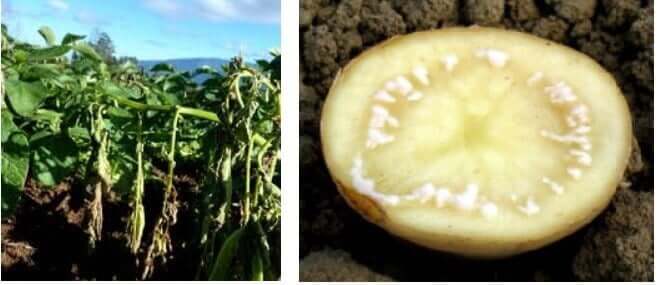
In potato, it transmits by the tubers. The incidence of the disease is higher at high soil moisture, such as during rainy periods. If the temperature is low, the infection may remain latent until the conditions are more favorable. Due to it is more difficult to recognize the infected fields. This disease is widespread in North America and Russia where it causes a lot of damage.
Symptoms and Damages
Symptoms in the aerial part of this bacterium wilt are stunting and yellowing of the foliage. These symptoms can appear at any vegetative stage of the crop. Leaf wilting and stem collapse is more severe in young plants.
First, the withered leaves are become pale green in color, then brownish without the marginal portions of the leaflets.
At the stems of young plants, black streaks corresponding to infection of the vascular system can observe through the epidermis. Under conditions of high relative humidity, browning accompanied by leaf petiole rot may observe.
When the disease is advanced, a greyish brown discoloration may be visible through the epidermis of the tubers. Slight pressure on a section of an infected tuber will result in a greyish white bacterial exudate from the vascular ring.
At the level of the lenticels and sometimes at the end of the stolons of a severely attacked tuber, a sticky exudate is formed causing the attachment of soil particles to the surface of the tubers. This does not occur in the case of tubers infected with Clavibacter michiganensis subsp sepedonicus(ring rot). This criterion distinguishes between ring rot and bacterial wilt of the potato.
Pathogen
Clavibacter michiganensis is a Gram + bacterium. It does not have any alternative hosts apart from the potato. The ideal condition for its propagation is cool and wet weather. The bacteria remain active up to 0 ° C and this virulence can be maintained for 18 months.
Crop residues (stems, leaves, tubers left in soil) and agricultural tools are the main vectors. The bacterium is transmitted by biting aphids and leafhoppers, contaminated agricultural tools, and infected seeds.
Three strains of Pseudomonas solanacearum were distinguished according to pathogenic specialization and certain biochemical criteria. The pathogenic strain on a banana is not very virulent on the potato. On the other hand, pathogenic strains on tomato and tobacco are always virulent on the potato.
The optimum growth temperature for most species is 30 to 32 ° C. Some species originating in Colombia grow best at temperatures below 30 ° C. The virulent or avirulent forms can be easily differentiated on the medium peptone, casein, glucose, and agar containing 2, 3, 5-triphenyl tetrazolium chloride.
Colonies of virulent species have an irregular shape and are whitish with a pink center. On the other hand, the colonies of the avirulent species have a uniformly circular shape and are dark red in color.
The life cycle of Bacterial Wilt of Potato
Infected tubers are the most important factor in the distribution and severity of the disease in tropical countries. Temperature plays a very important role in geographical distribution. The disease is rarely observed in areas where the average soil temperature is below 15 ° C. Soil type does not appear to have an effect on the development of bacterial wilt of the potato.
How to Control Bacterial Wilt of Potato
- Use disease-free spreading material (seed, seedlings, tubers).
- Disinfect cutting tools and knives.
- Control root rot nematodes, because the wounds of the roots help the bacteria infect the crop.
- Do not use cut potatoes for propagation, since they can increase the incidence of the disease by up to 250%.
- Quarantine measures should apply, ban growing potatoes in the field during the five years following the finding of infection of potatoes from that field.
The expression of resistance is influenced by the temperature and humidity of the soil, the light, and the photoperiod. High temperatures with low light intensity increase susceptibility of the potato to bacterial wilt.
The recent studies have highlighted some species of Pseudomonas fluorescens that appear to be very useful for biological control against Pseudomonas solanacearum.
Bacterial Wilt of Cucurbits (Cucumber, Pumpkin, and Squash)
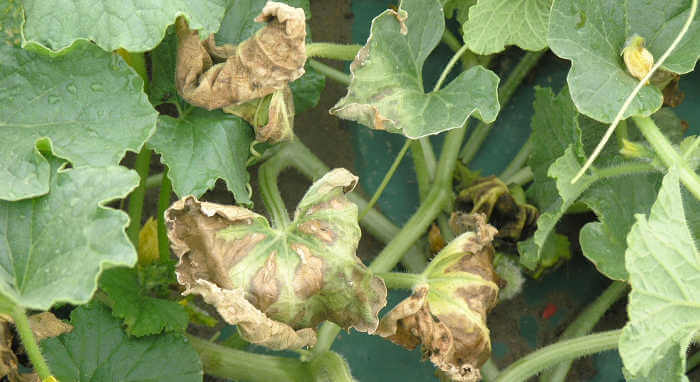
Symptoms and Damages
The plants fade even when they have been well watered. You can test by cutting a badly faded cucurbits stem just above ground level and squeezing it. If a sticky, oozing substance comes out, it’s bacterial wilt. This viscous substance clogs the circulatory system of the plant, so the plant cannot absorb the water.
Damage occurs quickly in cucumbers pumpkin and muskmelons. In a week of infection, you can begin to see dull spots on the leaves. Within 2 weeks, the whole vine will fade and the fruits will start to appear small and distorted. Very often, there is no yellowing of the leaves. Squash slowly show symptoms, but growth may slow down.
Causes of Bacterial Wilt on Cucurbits
A bacterium (Erwinia tracheiphila) which spreads when the Cucumber beetle and Colorado beetle feeds on the leaves of the plant. These beetles can also spread the cucumber mosaic virus.
The striped cucumber beetle, shown on the right, is about 1/4 “(6 mm) long with 3 black bands on its yellow-green wings.
The spotted cucumber beetle is similar yellow-green in color with twelve blacks. The larvae of both beetles feed on more types of plants than the cucurbits.
The larvae of both beetles are white with darker heads and hind legs and can be found in the soil under your cucumber plants.
How to Control Bacterial Wilt Control of Cucurbits
- Healthy Plants: For starters, cucumber beetles prefer to feed on faded plants and faded plants are already more prone to infection. Keep your plants watered and healthy.
- Resistant varieties: Choose resistance varieties that are more tolerant to cucumber beetles.
- Watch out early: However, prevent beetles is the best control. Beetles come in early spring and lay their eggs on the underside of the leaves. Monitor the leaves and destroy the egg sacs by removing or crushing them.
- Barriers: You can protect early cucurbits plantations by covering plants netting or porous fabric. Just remove the lid when the flowers appear.
- Pesticides: Cucurbits are very sensitive to pesticides, so use them as a last resort and follow the instructions on the label. Spraying at night is more effective. Rotenone and pyrethrin containing insecticides are recommended.
- Predators: There are some natural predators. The tachinid fly and the braconid wasp will provide some control, just like a soldier’s beetle.
If your vines are infected, they must be removed and removed. There is no cure for bacterial wilt. Remove all the infected vines.
Bacterial Wilt of Rice
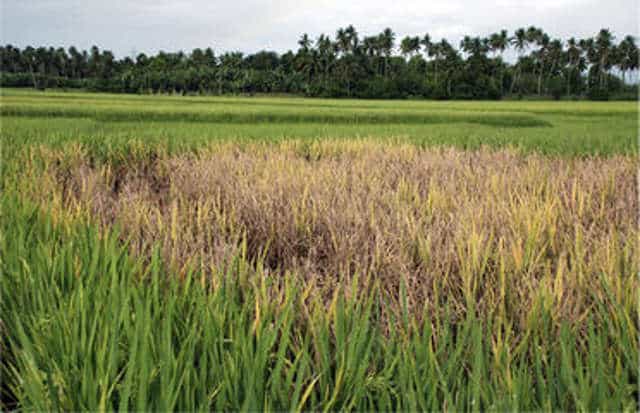
Bacterial wilt of rice is a very destructive disease for rice producers. Because of this disease only in Asia, yield losses can go beyond 50% in this year.
Symptoms and Damages
A small wet spot appears on the periphery of the lower leaves of the seedlings when the disease is reported. This stain eventually spreads and causes the yellowing of these leaves. Later, they dry and fade. Lesions appear on the blade, usually towards the edges from the tip, and grow larger with a wavy outline.
They become yellow and dry and soak the neighboring areas of the healthy parts. Rice grains can affect by the disease in highly contaminated fields. Appear wet margin surrounded patches of altered color on the glumes. In addition to these symptoms, we notice in the tropics a drying of leaves and whole plants.
Pathogens
Proteobacteria of the genus Xanthomonas including Xanthomonas oryzae is the cause of the bacterial wilt of rice. This type of pathogen attacks rice crops with the help of spring moisture and generally comes into activity four weeks after the end of flowering.
How to Control Bacterial Wilt of Rice
Already know in the absence of effective treatments for the disease, the treatment is essentially based on the adoption of good cultural practices. For this purpose,
- Use healthy and unharmed seed.
- Remove and burn all the contaminated straw.
- Rotating the crops.
- Apply the optimum level of fertilizer and avoid higher doses of nitrogen which favor the contamination of the plant. It is also necessary to plan rice planting well so that weather conditions unfavorable to the proper development of pathogens coincide with the vulnerable stages of plant emergence.
- Several weeds such as Leersia solyanka and Zizania latifolia are hosts of Xanthomonas proteobacteria. Therefore, it is necessary to remove them before cultivation.
You invest a lot of time, labor, and money in growing vegetables and crops. I know-how is the pain if a disease destroys everything. I have tried to cover all the topics related to bacterial wilt. If you have any other queries, ask me in the comment section below. I hope this bacterial wilt treatment guide can help you.

